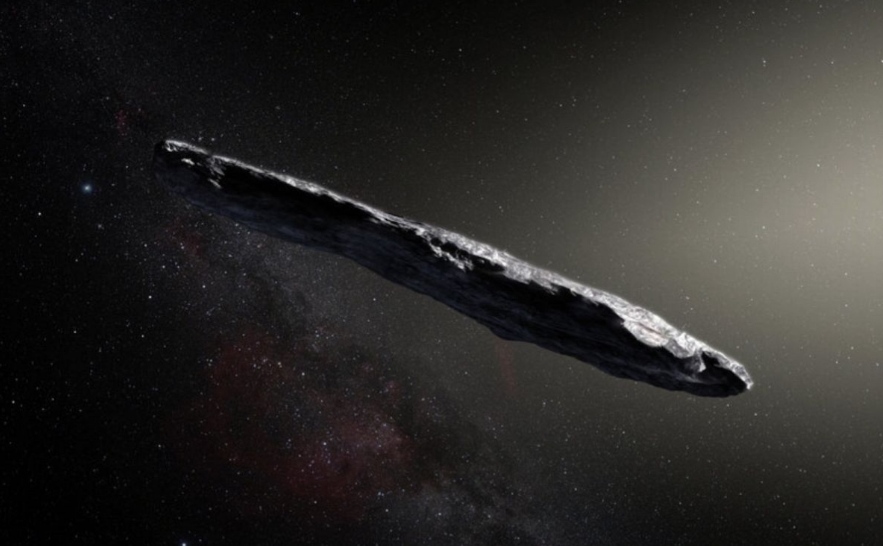Interstellar visitor ‘Oumuamua could still be alien technology, new study hints

By
Rafi Letzter
Aliens? Or a chunk of solid hydrogen? Which idea makes less sense?
‘Oumuamua — a mysterious, interstellar object that crashed through our solar system two years ago — might in fact be alien technology. That’s because an alternative, non-alien explanation might be fatally flawed, as a new study argues.
But most scientists think the idea that we spotted alien technology in our solar system is a long shot.
In 2018, our solar system ran into an object lost in interstellar space. The object, dubbed ‘Oumuamua, seemed to be long and thin — cigar-shaped — and tumbling end over end. Then, close observations showed it was accelerating, as if something were pushing on it. Scientists still aren’t sure why.
One explanation? The object was propelled by an alien machine, such as a lightsail — a wide, millimeter-thin machine that accelerates as it’s pushed by solar radiation. The main proponent of this argument was Avi Loeb, a Harvard University astrophysicist.
Most scientists, however, think ‘Oumuamua’s wonky acceleration was likely due to a natural phenomenon. In June, a research team proposed that solid hydrogen was blasting invisibly off the interstellar object’s surface and causing it to speed up.
Now, in a new paper published Monday (Aug. 17) in The Astrophysical Journal Letters, Loeb and Thiem Hoang, an astrophysicist at the Korea Astronomy and Space Science Institute, argue that the hydrogen hypothesis couldn’t work in the real world — which would mean that there is still hope that our neck of space was once visited by advanced aliens — and that we actually spotted their presence at the time.
Related: ‘Oumuamua: Our 1st interstellar visitor explained in photos
Here’s the problem with ‘Oumuamua: It moved like a comet, but didn’t have the classic coma, or tail, of a comet, said astrophysicist Darryl Seligman, an author of the solid hydrogen hypothesis, who is starting a postdoctoral fellowship in astrophysics at the University of Chicago.
‘Oumuamua was the first object ever seen flying into our solar system and back out again. That’s opposed to most solar system objects that turn circles around the sun, never leaving the celestial neighborhood.
Its journey and the fact that it was accelerating suggested ‘Oumuamua, which is estimated to be about 1,300 to 2,600 feet (400 to 800 meters) long, was a comet. And yet, “there was no ‘coma’ or outgassing detected coming from the object,” Seligman said.
Normally, comets come from regions more distant from the sun than asteroids, and ice on their surface turns straight into gas as they approach the sun, leaving behind a trail of gas, or what we see as a beautiful comet tail, Seligman said.
That outgassing changes how the comet moves through space, he said. It’s a bit like a very slow rocket engine: The sun strikes the comet, the warmest part of the comet bursts with gas, and that gas flowing away from the comet sends it tumbling faster and faster away from the sun.
In a paper published June 9 in The Astrophysical Journal Letters, Seligman and Yale astrophysicist Gregory Laughlin proposed that the object was a comet made up partly or entirely of molecular hydrogen — lightweight molecules composed of two hydrogen atoms (H2).
H2 gas freezes into a puffy, low-density solid only when it’s very cold — minus 434.45 degrees Fahrenheit (minus 259.14 degrees Celsius, or just 14.01 degrees above absolute zero) in Earth’s atmosphere. Researchers had already proposed the existence of “hydrogen icebergs” out in the very cold reaches of space, Laughlin and Seligman wrote in the study. And outgassing hydrogen wouldn’t be visible from Earth — meaning it wouldn’t leave behind a visible comet tail.
The numbers worked out neatly; while a few other substances (like solid neon) could potentially explain the coma-free acceleration, hydrogen was the best match for the data.
But in their new paper, Hoang and Loeb respond to this idea and argue that the hydrogen iceberg explanation has a basic problem: Comets form when icy grains of dust bump into each other in space and form clumps, and then those clumps attract more dust and other clumps. And comets are like snowmen: they survive only as long as they don’t melt.
The stickiness that helps form comets is similar to the stickiness of ice cubes coming straight out of a cold freezer. Leave an ice cube on the counter for a minute or two, let its surface warm up a bit, and it won’t feel sticky anymore. A thin film of liquid water on its surface makes it slippery.




